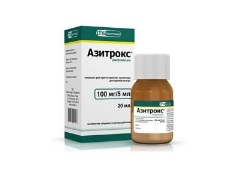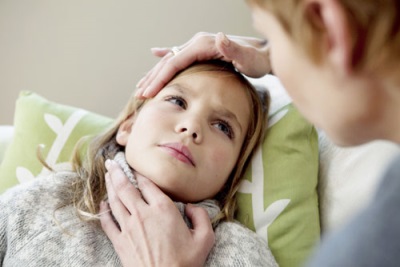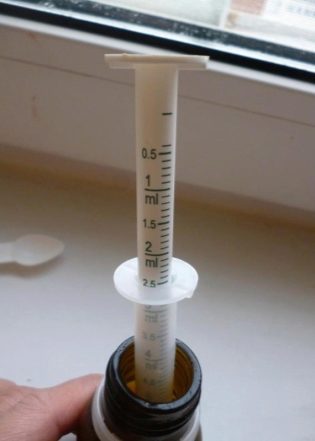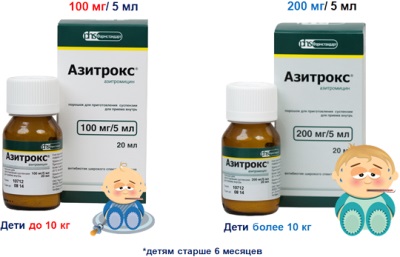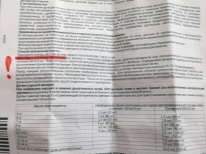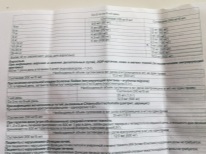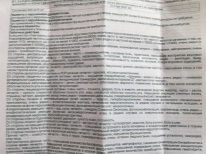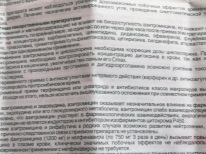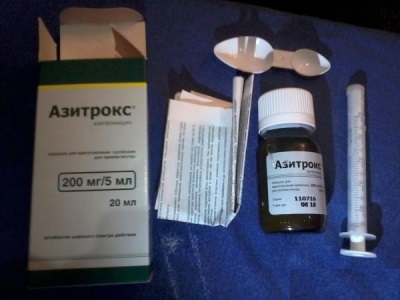Suspension "Azitroks" for children: instructions for use
One of the antibiotics in demand for the treatment of infectious diseases is Azitrox. Is it possible to give it to a small child, in what dosage the treatment is carried out and what side effects can be expected from such a medicine?
Release form
Azitrox is presented in several forms, but for children it is considered the most convenient powder, from which a suspension is prepared for a sick baby. It is presented in two versions, differing only in the dosage of the active substance. The powder weighing 15.9 grams is filled in a dark glass bottle that can hold 50 ml of liquid. In the package there is a pipette, as well as a measuring spoon.
The powder itself looks like granules or white crystals (may be cream or yellow), and the medicine prepared from it after adding water is a uniform yellow-white or cream-white liquid, which has a fruity odor.
Azitrox can also be purchased in capsulated form. Such capsules can contain 250 or 500 mg of active substance, and in one package are 6 capsules (250 mg each) or 3 capsules (500 mg each).
Composition
The main ingredient in Azitrox is represented by azithromycin (it is in the form of dihydrate). In a preparation with a dosage of 100mg / 5ml of such a substance contains 400 mg, and in vials of 200mg / 5ml there is 800 mg of azithromycin.
The sweet taste, thanks to which the prepared solution resembles syrup, provides sucrose to Azitrox. Additionally, the drug contains hyprolosis, sodium carbonate and xanthan gum. The pleasant smell of the suspension is due to the presence of cherry, vanilla and banana in the composition of the flavors.
Operating principle
The drug is an antibiotic, which belongs to the group of macrolides. He has a rather extensive spectrum of therapeutic action, therefore Azitrox is effective against many microorganisms, including intracellular and anaerobic bacteria. The drug inhibits the processes of protein synthesis in microbial cells, because of which the reproduction of the pathogen slows down. In this case, a high dosage can have a bactericidal effect.
Streptococci, mycoplasmas, staphylococci, haemophilus bacilli, gonococci, legionella, chlamydia, clostridia and many other microorganisms are sensitive to Azitrox. Only some types of staphylococci, bacteroids, pneumococci and enterococci can be resistant to such an antibiotic, therefore, before starting treatment, it is worth checking the sensitivity of the pathogen.
Acceptance of Azitrox causes the maximum concentration of its active substance in the blood within 2-3 hours. The drug is able to penetrate cell membranes and tissue barriers. When the last dose is taken, the therapeutic concentration of the drug will continue for another 5-7 days after completion of treatment.
In the video below, a practicing dermatovenereologist answers the most frequently asked questions about the antibiotic azithromycin, which is the main active ingredient of Azitrox:
Indications
Reception Azitroks recommended in such cases:
- With angina, otitis, sinusitis and other infections localized in the upper respiratory tract and upper respiratory tract.
- With bronchitis or pneumonia.
- In inflammatory pathologies of the urinary tract, triggered by susceptible microbes.
- With acne, erysipelas, dermatosis and other skin infections.
- In the initial stage of Lyme disease.
At what age is it allowed to take?
Treatment with Azitrox suspension is acceptable after 6 months of age. However, in childhood, for example, in a year, at 3 years or 5 years, only a doctor should prescribe this drug. Azitroks capsules are taken from 12 years of age.
Contraindications
The drug should not be given in case of intolerance to macrolides or auxiliary components of the drug. Also, the use of Azitrox is advised to avoid when:
- Severe disruption of the liver.
- Impaired renal function.
- Deficiency sucrase.
- Glucose-galactose malabsorption.
- Problems with tolerance of fructose.
- Treatment with dihydroergotamine or ergotamine.
Very carefully, doctors prescribe Azitrox for diabetes, moderate liver impairment, myasthenia, and arrhythmias.
Side effects
A child’s body often reacts to Azitrox with dizziness, poor appetite, paresthesias, headache, decreased visual or hearing acuity, impaired taste, nausea, abdominal pain, bloating, diarrhea, itching, weakness or pain in the joints.
The rarer side effects of taking Azitrox are:
- Reducing the number of eosinophils and lymphocytes.
- Nervous condition, drowsiness or insomnia.
- Noise in ears.
- Vomiting.
- Constipation.
- Gastritis.
- Palpitations.
- Chest pains.
- Hepatitis.
- Quincke swelling, urticaria and other allergic reactions.
- Candidiasis.
Occasionally Azitrox can provoke thrombocytopenia, anemia, fainting, aggressive or anxious behavior, convulsions, deafness, arrhythmia, low blood pressure, pancreatitis, colitis, nephritis, and other problems.
Instructions for use
How to dilute powder
To prepare the suspension, 9.5 milliliters of water is poured into the vial, which is first brought to a boil and then cooled. For the exact amount of water for dilution, use the pipette inside the package. Shaking the powder poured in with water, it is necessary to achieve a uniform liquid. The resulting suspension will be presented in a volume of 20 ml.
How often to take
The drug is recommended to be taken once a day.by shaking the vial before use. The suspension is given to the child at the required dose one hour before feeding, or two hours after eating. For dosage, use either a measuring spoon or a pipette.
Immediately after swallowing the syrup, give the baby some water.. This will help to clear the oral cavity of the drug and swallow it completely. Spoon or pipette well washed under running water and after drying kept in the package Azitrox.
If the child has forgotten to give the next dose of medication, it should be drunk immediately, as detected, and the next time to give Azitrox after 24 hours.
Dosage
The dose of the drug for a small child is determined individually, for the calculation requires to know the body weight of the baby. The number of kilograms multiplied by 10 mg and receive a single dosage of Azitrox. For example, a child weighs 7 kilograms, then he is given a drug per day at the rate of 70 mg of the active substance.
For babies weighing less than 10 kg, a vial containing 100 mg of azithromycin in 5 ml of the prepared suspension is used. Children weighing 5 kg give 2.5 ml of the drug (this corresponds to 50 mg), with a weight of 6 kg - 3 ml and then 0.5 ml is added to each additional kg (this volume contains 10 mg of azithromycin).
With a weight of 10-14 kg, a child is given 5 ml of this form of medicine. If the baby weighs more than 15 kg, it is more convenient to use a bottle with a greater concentration of azithromycin. However, this medicine can be given with less weight.His single dose will be:
For a child weighing 6 kg | 1.5 ml suspension (contains 60 mg of active substance) |
For a baby weighing 7 kg | 1.8 ml of the medicine (will give 70 mg of azithromycin) |
For crumbs weighing 8 kg | 2 ml of the drug (includes 80 mg of antibiotic) |
For babies weighing 9 kg | 2.3 ml of suspension (contains 90 mg of active ingredient) |
Weight from 10 to 14 kg | 2.5 ml of medication (100 mg azithromycin) |
Weight from 15 to 24 kg | 5 ml of the preparation (contains 200 mg of active substance) |
Weighing from 25 to 34 kg | 7.5 ml suspension (300 mg antibiotic) |
Weight from 35 to 44 kg | 10 ml of medicine (gives 400 mg of active ingredient) |
If the child weighs more than 45 kg, he can be given 12.5 ml of suspension or go to capsules, because a single dose will be 500 mg.
Treatment of Lyme disease begins with an overdose of medication. On the first day of therapy, a drug is given at the rate of 20 mg per kg of baby weight. Further, the dosage is reduced to 10 mg per 1 kg.
How many days to take
The duration of treatment with Azitrox for infections of the respiratory tract or soft tissues is 3 days. When treating Lyme disease, the medication is taken 5 days.
Overdose
Excess dose of Azitrox threatens to increase the side effects of the drug, for example, temporary hearing loss, severe nausea, dilution of stools, bouts of vomiting and other symptoms. The child should immediately be given a sorbent and, if strongly ill, call a doctor.
Interaction with other drugs
Azitrox intake should not be combined with antacid drugs, because they reduce its bioavailability. The simultaneous administration of such an antibiotic and digoxin, cyclosporine, terfenadine, quinidine and certain other drugs should be very careful and carried out under the supervision of a physician.
Terms of sale
To buy Azitrox in a pharmacy, you need to get a prescription from a doctor. The average price of a bottle with 100 mg of active ingredient in 5 ml of the prepared suspension is 180-190 rubles, and a bottle with 200 mg of azithromycin in 5 ml of the finished medicine costs about 300 rubles.
Storage conditions and shelf life
Azitrox powder in a closed vial can be stored for 2 years from the date of production. The finished suspension should be stored no longer than five days. A bottle of liquid can be kept at room temperature (not higher than + 25 ° C). Freezing the suspension is unacceptable.
Reviews
Parents who gave Azitrox to their children with infections leave mostly good reviews about the medicine. The advantages of the drug are quite fast effect, pleasant taste and convenience of preparing the suspension. Moms say that dispensing such a drug is easy, and most babies do not protest against this sweet medicine.
Another advantage is the short duration of treatment and a single dose per day. As for the shortcomings, the main disadvantages are the side effects of Azitrox. Most often, children have a rash, diarrhea, abdominal pain and weakness.
Analogs
Replace Azitroks capable drugs in which the active substance also acts azithromycin. The most popular are such analogues:
- Azithromycin. Such an inexpensive antibiotic is available in tablets (their dosage is 125, 250 or 500 mg) and capsules.
- Sumamed. The powder form of such a drug is prescribed to the smallest, and for older children, capsules or tablets are used.
- AzitRus. This variant of azithromycin is presented in ration bags. Dissolving its contents, you get the desired single dose of medication.
- Hemomycin. Such a preparation is represented by a dilution powder and tablets.
